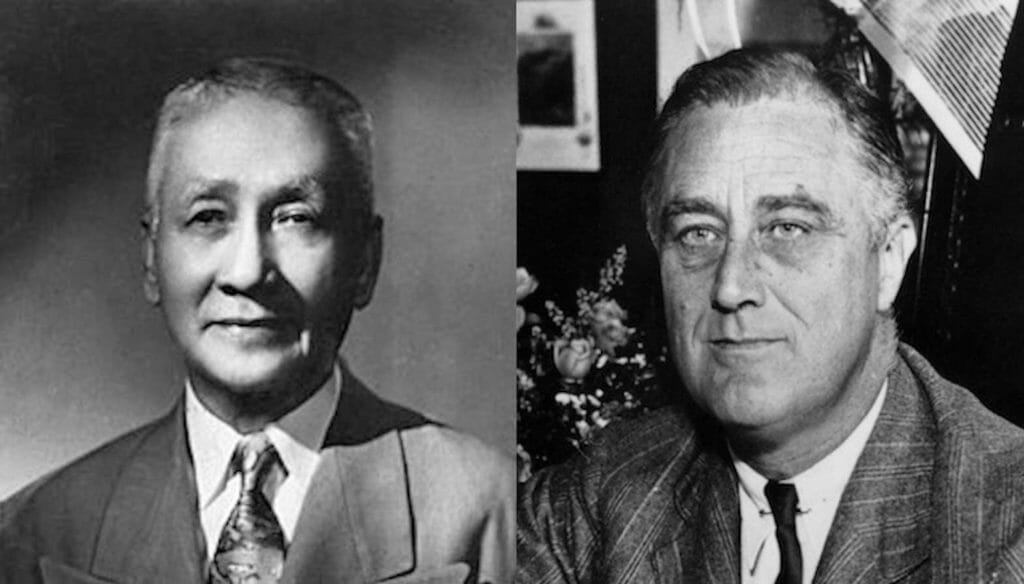When Pres. Osmena met Pres. Roosevelt, April 5, 1945

President Roosevelt’s final press conference before he died was with President Osmena on the topic of the Philippines.
One of the towering figures of World War II was President Franklin D. Roosevelt (FDR) of the United States. He had dominated American politics and foreign policy since he was inaugurated in 1933. He was also a good friend of the Philippines and was an advocate for Philippine commonwealth status and eventual independence.
The United States Congress had passed the Tydings-McDuffie Act in 1934, and President Roosevelt signed it on March 24, 1934. He also lobbied U.S. Senators to approve the Act. The legislation provided United States assistance during a ten-year transition period for Philippine independence. The Act required an election for president and other vital positions in the Commonwealth government. The date of independence was scheduled for July 4, 1946.
Unfortunately, World War II and the Japanese occupation of the Philippines interrupted the ten-year transition period. For most of that period, the Commonwealth government was in exile in the United States.
Following the death of the first Philippine Commonwealth President, Manual Quezon in August 1944, the Vice President of the Commonwealth, Sergio Osmena, was inaugurated President at a solemn ceremony in Washington, D.C.
Shortly, President Osmena headed to the Pacific Theater to return to the Philippines. The landing of American forces occurred on October 20, 1944, at Leyte. The Commonwealth government in exile had now returned to the Philippines. The Commonwealth government under President Osmena was reestablished in Manila on February 27, 1945. The Philippine Commonwealth government was finally home.
President Osmena saw firsthand the destruction of Manila. Approximately ¾ of the city was in ruins. The cost of rebuilding the Pearl of the Orient would require a significant infusion of money and resources. Mostly likely, the funding would come from the United States. President Osmena decided to visit President Roosevelt at the Little White House in Warm Springs, Georgia. The meeting was scheduled for April 5, 1945.
The Little White House in Georgia played a significant role in the life of the 32nd President of the United States. In 1921, Roosevelt had contacted polio. His first visit to Warm Springs was in 1924. The hot spring swimming pools brought comfort, exercise, and strength for people suffering from polio. Eventually, Roosevelt bought the rundown resort in 1926. He was able to regain a substantial amount of his strength which allowed him to pursue a political career again. In 1932, he built the Little White House close to the swimming pools.

In April 1945, there were only two visitors to Roosevelt’s Little White House in Warm Springs, Georgia, shortly before he died. President Osmena was one of them. US.GOV
In April 1945, there were only two visitors to Roosevelt’s Little White House. President Osmena was one of them. Unfortunately, President Roosevelt died on April 12, 1945, only seven days after the Osmena’s meeting. Roosevelt’s health had been declining for months. Sadly, he was not able to witness the victory and end of World War II.
Following the Osmena and Roosevelt meeting on April 5, 1945, a press conference was held at Warm Springs. It turned out that this was the last press conference of the Roosevelt presidency. His illustrious presidency had 998 press conferences. FDR’s last press conference was about the Philippines.
FDR began the 2 p.m. press conference by stating that Osmena and he were “…having a nice talk…” He said that President Osmena was just back from the Philippines and that he gave FDR an update on the active military campaign in the Philippines. Osmena also described to him the horrible destruction of Manila that he had witnessed. Roosevelt said that the Filipino guerrilla forces have been greatly helping American military operations.
FDR continued by stating that Philippine independence was still on track for July 4, 1946. He said that the Philippines would need help rebuilding bridges and roads. The sea ports would need the removal of debris to facilitate trade especially in the port of Manila. He said that Cathedral of Saint Dominic would be restored to its previous grandeur. The prewar economy and trading partners would need to be reestablished.
Finally, FDR outline the post-World War II military strategy of maintaining American military bases in the Philippines. According to FDR, naval and air bases were needed to protect the Pacific. The bases were “to take care of that section of the Pacific.”
Following FDR’s statement on the Philippines, the press conference was opened to reporters for questions and answers. Once again, FDR dominated the event. This was not unusual when he had a joint press conference.
It is fascinating that Roosevelt’s final press conference was with President Osmena on the topic of the Philippines. If FDR had not died only seven days later, maybe post-war Philippines would have received more U. S. attention and financial support. We can only speculate.
Dennis Edward Flake is the author of three books on Philippine-American history. He is Public Historian and a seasonal park ranger in interpretation for the National Park Service at the Eisenhower National Historic Site in Gettysburg, PA. He can be contacted at: flakedennis@gmail.com

